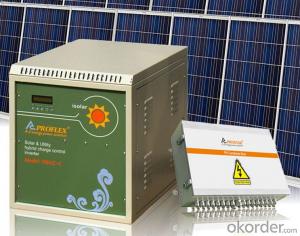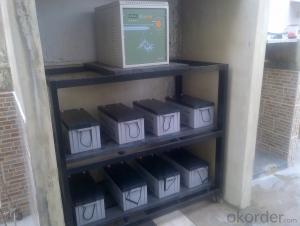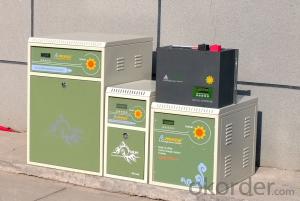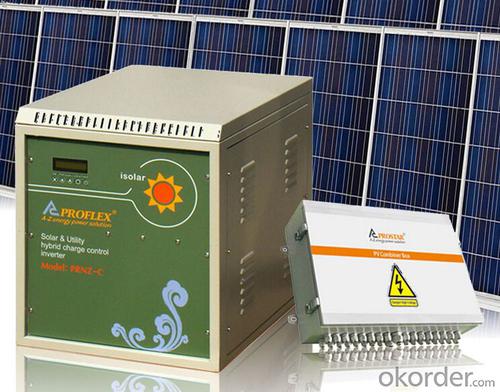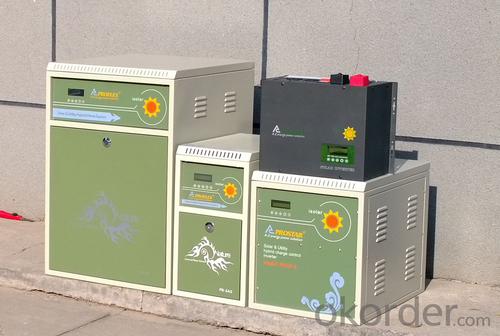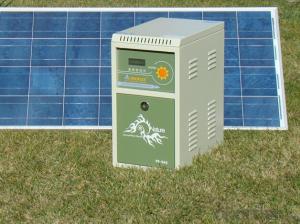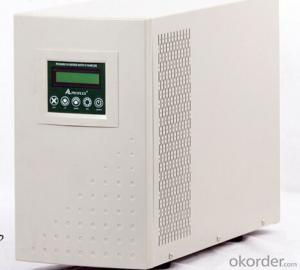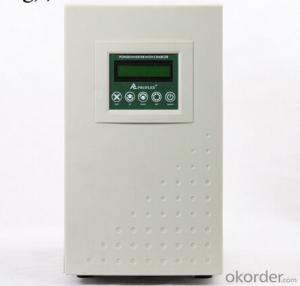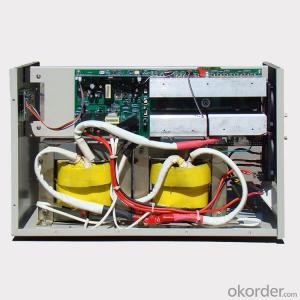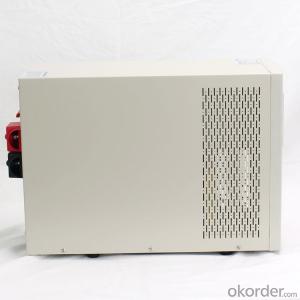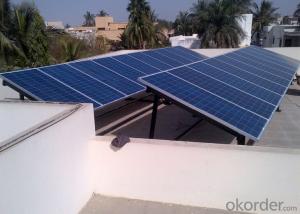Solarcity Solar Energy Systems - Sun Power Off Grid System 300W Design Backup Time 5-6hrs
- Loading Port:
- Tianjin
- Payment Terms:
- TT OR LC
- Min Order Qty:
- 10 unit
- Supply Capability:
- 10000 unit/month
OKorder Service Pledge
OKorder Financial Service
You Might Also Like
Specification
Sun power off grid system
Design Backup Time 5-6Hrs | |||
Solar Module | Maximum power at STC(pm) | 150W solar panel(polycrystalline) 2pcs 75W,2pcs parallel | |
Max.system charging voltage | 17.6V | ||
Max.system charging current | 8.54A | ||
Inverter | Output waveform | Low frequency pure sine wave | |
Continuous output power | 300W | ||
Output voltage/frequency | 220V/50HZ | ||
Charge controller | Syetem voltage | 12V | |
Rated discharge current | 15A | ||
Cabinet | Material | Steel box of zinc-plated and laquer-coated | |
Battery | Type | Deep cycle | |
System voltage | 12V | ||
capacity | 1pcs 12V 100Ah | ||
operating temperature | -20℃-+55℃ | ||
Packing(CBM/KG) | Solar panel | 0.06CBM/20KGS | |
Control box | 0.11CBM/15KGS | ||
Battery | 0.02CBM/31KGS | ||
Whole system | 0.19CBM/66KGS | ||
Daily use reference | |||
Name of load | Power | Working hours | Consumption |
TV | 70W | 4hours | 280Wh |
LAPTOP | 60W | 2hours | 120Wh |
LIGHTING | 30W | 6hours | 180Wh |
FAN | 50W | 6hours | 300Wh |
TOTAL | 210W | 880Wh | |
Daily use reference
TV 70W x 4 hours
Lighting 30W x 6 hours
Fan 50W x 6 hours
Laptop 60W x 2 hours
Total loading power: 210W
Total power consumption per day: 880Wh (0.88kWh/day)
AC solar power system consists of solar batteries, solar controller, battery, inverter components.
Used to solve rural or remote areas without electricity, such as highland, island, pastoral, villas, border posts and other military and civilian life electricity.
FAQ
1. How do I decide which system is right for me ?
For protection from long outages, include a generator or solar panels in your Must solar system. Shorter outages can be handled by a battery-only system.
2. Where my system will be installed ?
Must solar systems are usually wall-mounted near a home's main electrical (circuit breaker) panel.
3. How do I install my system ?
A solar backup inverter is connected to a home electric system , we will supply detailed installation manual and videos for our customers .
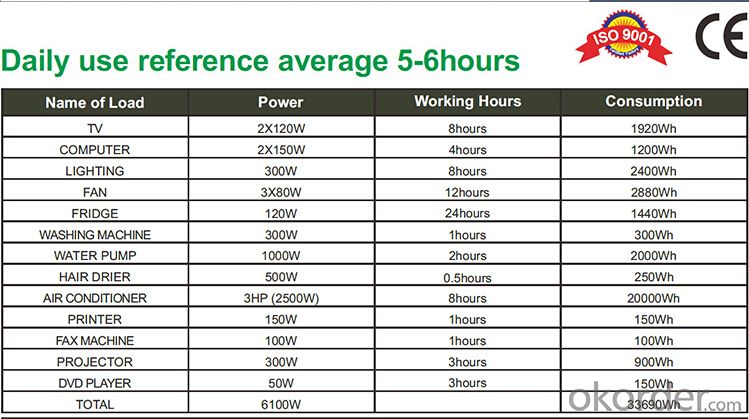

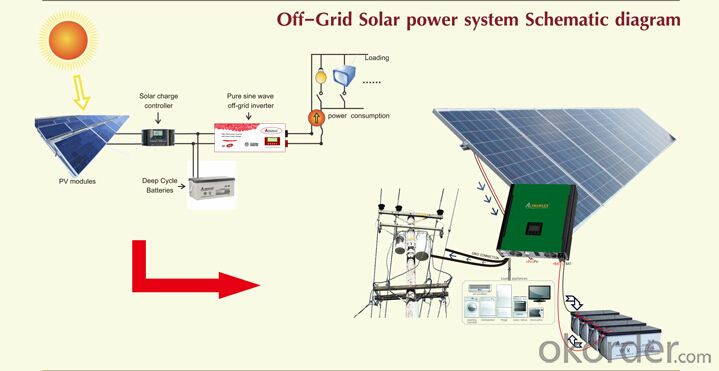
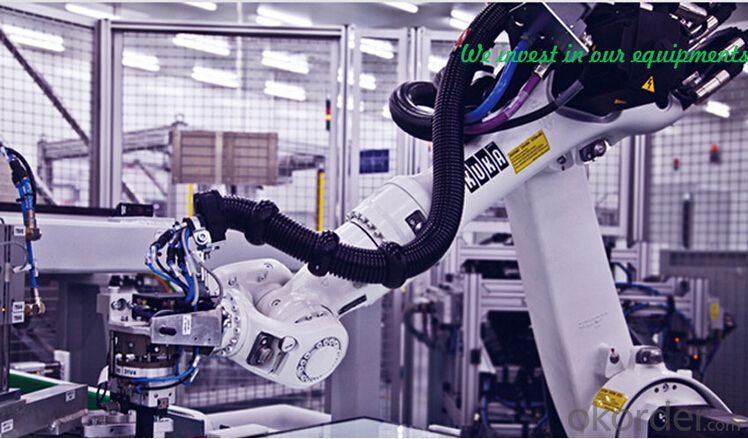
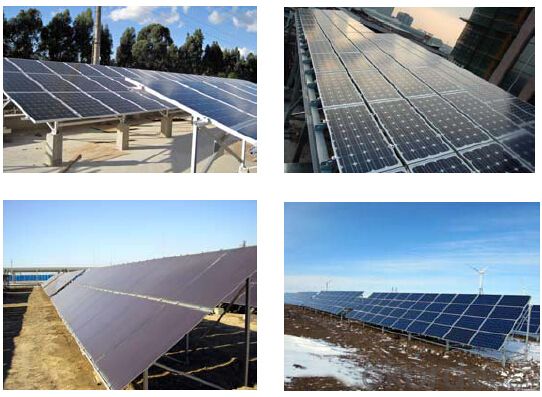


- Q: Can solar energy systems be used in mining operations?
- Yes, solar energy systems can be used in mining operations. Solar power can provide a sustainable and reliable source of electricity for various mining activities, such as powering equipment, lighting, ventilation, and processing plants. It reduces dependence on traditional fossil fuel-based energy sources, lowers operational costs, and minimizes environmental impacts. However, the feasibility and effectiveness of solar energy systems in mining operations depend on factors like location, energy demands, and technical considerations.
- Q: How can I calculate the size of a solar energy system for my home?
- To calculate the size of a solar energy system for your home, you will need to consider a few factors. Here are the steps you can follow: 1. Determine your energy consumption: Start by examining your past energy bills to understand your average monthly energy usage in kilowatt-hours (kWh). This will give you an idea of how much electricity your solar system needs to generate. 2. Assess your location: The amount of sunlight your home receives depends on its location. Check the solar resource map for your region to estimate the average daily solar radiation in your area. This information will help you determine the solar panels' efficiency. 3. Calculate your energy needs: Multiply your average monthly energy usage in kWh by 12 to get your annual energy consumption. Divide this number by 365 to find your daily energy consumption. 4. Determine solar panel output: Solar panels have a wattage rating that indicates the amount of power they can generate under ideal conditions. Divide your daily energy consumption by the average daily solar radiation to estimate the number of solar panels you need. For example, if your daily energy consumption is 40 kWh and the average daily solar radiation is 5 kWh/m2, you would need an 8 kW solar system (40 kWh / 5 kWh/m2 = 8 kW). 5. Account for system losses: Solar systems experience losses due to factors such as shading, dirt, and inefficiencies in the inverter. To compensate for these losses, multiply the estimated system size by a derating factor, typically ranging from 0.75 to 0.9. This will give you the final system size you need. 6. Consult with a professional: It is always recommended to consult with a solar energy professional or installer who can conduct a site assessment and provide accurate calculations based on your specific home and energy needs. They will consider additional factors like roof orientation, available space, and local regulations to ensure an optimal solar system size for your home. Remember, the size of your solar energy system also depends on your goals, budget, and available space. A professional consultation will help you make an informed decision and maximize the benefits of solar energy for your home.
- Q: How do solar energy systems impact the overall energy independence of a building?
- Solar energy systems can significantly increase the overall energy independence of a building. By harnessing the power of the sun, these systems generate clean and renewable electricity, reducing the reliance on traditional energy sources. With solar panels installed, buildings can produce their own energy, thereby decreasing dependence on the grid and potentially eliminating or significantly reducing electricity bills. This not only helps in achieving energy self-sufficiency but also contributes to a more sustainable and environmentally-friendly future.
- Q: Are there any limitations to installing a solar energy system in a homeowner's association?
- Yes, there can be limitations to installing a solar energy system in a homeowner's association (HOA). Some HOAs may have specific rules and regulations regarding the installation of solar panels, such as restrictions on the size, location, or appearance of the panels. Additionally, the HOA may require approval or permits before installing a solar energy system. It is important for homeowners to review the HOA's guidelines and consult with the association before proceeding with the installation.
- Q: Can solar energy systems be used for outdoor recreational activities?
- Yes, solar energy systems can definitely be used for outdoor recreational activities. Solar panels can be installed on rooftops, RVs, boats, and other outdoor structures to generate electricity. This renewable energy source can power various devices and equipment used during recreational activities such as camping, hiking, and boating. Solar energy systems provide a sustainable and environmentally friendly way to enjoy outdoor activities without relying on traditional power sources.
- Q: Can solar energy systems be used for powering recycling facilities?
- Yes, solar energy systems can be used to power recycling facilities. Solar panels can generate electricity from the sun's energy, which can then be used to power the various operations and machinery involved in recycling processes. This renewable energy source helps reduce carbon emissions and makes recycling facilities more sustainable and environmentally friendly.
- Q: How do solar energy systems affect the installation of satellite dishes?
- Solar energy systems can potentially impact the installation of satellite dishes by obstructing the line of sight between the satellite and the dish. This obstruction can cause signal interference or loss, affecting the satellite dish's performance. However, with proper planning and positioning of both the solar panels and the dish, it is possible to minimize any potential conflicts and ensure optimal functioning of both systems.
- Q: Can solar energy systems be used in areas with limited access to solar energy publications and resources?
- Yes, solar energy systems can still be used in areas with limited access to solar energy publications and resources. While access to information and resources can be helpful in understanding and maximizing the benefits of solar energy, it is not a prerequisite for utilizing solar energy systems. Basic knowledge of solar energy, combined with the availability of solar panels and equipment, can still enable individuals and communities to harness solar power for their energy needs. Additionally, local organizations, government initiatives, and international assistance programs can play a vital role in providing support and knowledge transfer to these areas, helping them overcome the limitations of accessing solar energy publications and resources.
- Q: Can solar energy systems be used in countries with low sunlight availability?
- Yes, solar energy systems can still be used in countries with low sunlight availability. While it is true that solar energy systems rely on sunlight to generate electricity, advancements in technology have made it possible to capture and utilize even small amounts of sunlight efficiently. Additionally, solar energy systems can be designed to incorporate other renewable energy sources, such as wind or hydroelectric power, to supplement low sunlight availability. Furthermore, using energy storage systems, such as batteries, can help store excess energy during periods of low sunlight and release it when needed. Therefore, even in countries with low sunlight availability, solar energy systems can still be a viable and sustainable option for generating electricity.
- Q: Can solar energy systems be used for powering industrial processes?
- Certainly, industrial processes can be powered by solar energy systems. In recent years, solar power has gained popularity as a sustainable and renewable energy source. The energy demands of industrial processes are often substantial, and solar power can be harnessed to meet these requirements. There are various ways in which solar energy systems can be utilized for industrial processes. One common approach involves installing solar photovoltaic (PV) panels. These panels convert sunlight directly into electricity, which can then be used to power industrial machinery and equipment. By integrating solar PV systems into existing infrastructure, industries can reduce their reliance on traditional fossil fuels and decrease their carbon footprint. In addition to generating electricity, solar thermal systems can also be employed to power industrial processes. Solar thermal technology uses the sun's heat to produce steam, which can then drive turbines or provide direct heat for industrial applications. This method is particularly beneficial for industries that require high-temperature processes, such as manufacturing, chemical production, or food processing. Implementing solar energy systems for industrial processes offers numerous advantages. Firstly, it helps to mitigate greenhouse gas emissions and combat climate change. Solar power is a clean energy source that emits no harmful pollutants or greenhouse gases during operation. By transitioning to solar energy, industries can contribute to a more sustainable and environmentally friendly future. Furthermore, utilizing solar power can lead to long-term energy cost savings for industries. Although the initial investment for installing solar energy systems may be significant, the operational costs are considerably lower compared to traditional energy sources. Once the systems are in place, industries can benefit from reduced electricity bills and even generate excess energy that can be sold back to the grid. Lastly, solar energy systems provide a reliable and resilient power source. They can function even in remote areas or during power outages, ensuring uninterrupted production processes. Additionally, solar panels have a long lifespan and require minimal maintenance, making them a viable long-term solution for industrial power needs. In conclusion, solar energy systems can indeed be utilized for powering industrial processes. With advancements in solar technology and an increasing emphasis on sustainability, more and more industries are embracing solar power to meet their energy demands. By harnessing the sun's energy, industries can reduce their environmental impact, save on energy costs, and ensure a reliable and resilient power supply for their industrial processes.
Send your message to us
Solarcity Solar Energy Systems - Sun Power Off Grid System 300W Design Backup Time 5-6hrs
- Loading Port:
- Tianjin
- Payment Terms:
- TT OR LC
- Min Order Qty:
- 10 unit
- Supply Capability:
- 10000 unit/month
OKorder Service Pledge
OKorder Financial Service
Similar products
Hot products
Hot Searches
Related keywords
